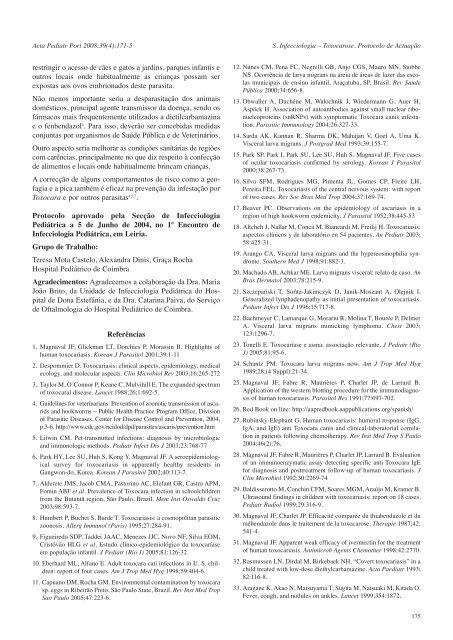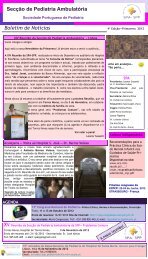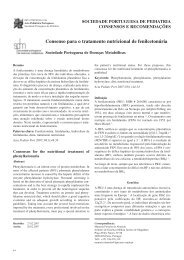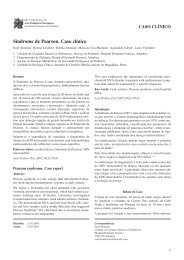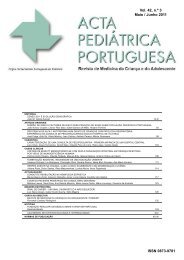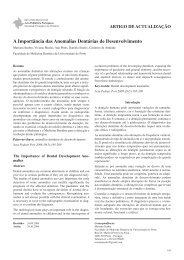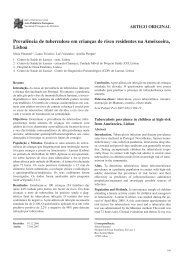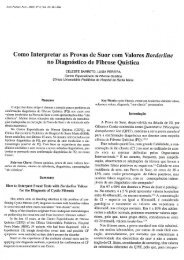Acta Ped Vol 39 N 4:Acta Ped Vol 39 N 4 - Sociedade Portuguesa ...
Acta Ped Vol 39 N 4:Acta Ped Vol 39 N 4 - Sociedade Portuguesa ...
Acta Ped Vol 39 N 4:Acta Ped Vol 39 N 4 - Sociedade Portuguesa ...
You also want an ePaper? Increase the reach of your titles
YUMPU automatically turns print PDFs into web optimized ePapers that Google loves.
<strong>Acta</strong> <strong>Ped</strong>iatr Port 2008:<strong>39</strong>(4):171-5<br />
S. Infecciologia – Toxocarose. Protocolo de Actuação<br />
restringir o acesso de cães e gatos a jardins, parques infantis e<br />
outros locais onde habitualmente as crianças possam ser<br />
expostas aos ovos embrionados deste parasita.<br />
Não menos importante seria a desparasitação dos animais<br />
domésticos, principal agente transmissor da doença, sendo os<br />
fármacos mais frequentemente utilizados a dietilcarbamazina<br />
e o fenbendazol 4 . Para isso, deverão ser concebidas medidas<br />
conjuntas por organismos de Saúde Pública e de Veterinários.<br />
Outro aspecto seria melhorar as condições sanitárias de regiões<br />
com carências, principalmente no que diz respeito à confecção<br />
de alimentos e locais onde habitualmente brincam crianças.<br />
A correcção de alguns comportamentos de risco como a geofagia<br />
e a pica também é eficaz na prevenção da infestação por<br />
Toxocara e por outros parasitas 4,5,7 .<br />
Protocolo aprovado pela Secção de Infecciologia<br />
<strong>Ped</strong>iátrica a 5 de Junho de 2004, no 1º Encontro de<br />
Infeccio logia <strong>Ped</strong>iátrica, em Leiria.<br />
Grupo de Trabalho:<br />
Teresa Mota Castelo, Alexandra Dinis, Graça Rocha<br />
Hospital <strong>Ped</strong>iátrico de Coimbra<br />
Agradecimentos: Agradecemos a colaboração da Dra. Maria<br />
João Brito, da Unidade de Infecciologia <strong>Ped</strong>iátrica do Hos -<br />
pital de Dona Estefânia, e da Dra. Catarina Paiva, do Ser viço<br />
de Oftalmologia do Hospital <strong>Ped</strong>iátrico de Coimbra.<br />
Referências<br />
1. Magnaval JF, Glickman LT, Dorchies P, Morassin B. Highlights of<br />
human toxocariasis. Korean J Parasitol 2001;<strong>39</strong>:1-11<br />
2. Despommier D. Toxocariasis: clinical aspects, epidemiology, medical<br />
ecology, and molecular aspects. Clin Microbiol Rev 2003;16:265-272<br />
3. Taylor M, O´Connor P, Keane C, Mulvihill E. The expanded spectrum<br />
of toxocaral disease. Lancet 1988;26;1:692-5.<br />
4. Guidelines for veterinarians: Prevention of zoonotic transmission of asca -<br />
rids and hookworms – Public Health Practice Program Office, Divi sion<br />
of Parasitic Diseases, Center for Disease Control and Pre ven tion, 2004,<br />
p.3-6, http://www.cdc.gov/ncidod/dpd/parasites/ascaris/prevention.htm<br />
5. Litwin CM. Pet-transmitted infections: diagnosis by microbiologic<br />
and immunologic methods. <strong>Ped</strong>iatr Infect Dis J 2003;23:768-77<br />
6. Park HY, Lee SU, Huh S, Kong Y, Magnaval JF. A seroepidemiological<br />
survey for toxocariasis in apparently healthy residents in<br />
Gangwon-do, Korea. Korean J Parasitol 2002;40:113-7.<br />
7. Alderete JMS, Jacob CMA, Pastorino AC, Elefant GR, Castro APM,<br />
Fomin ABF et al. Prevalence of Toxocara infection in schoolchildren<br />
from the Butantã region, São Paulo, Brazil. Mem Inst Oswaldo Cruz<br />
2003;98:593-7.<br />
8. Humbert P, Buchet S, Barde T. Toxocariasis: a cosmopolitan parasitic<br />
zoonosis. Allerg Immunol (Paris) 1995;27:284-91.<br />
9. Figueiredo SDP, Taddei JAAC, Menezes JJC, Novo NF, Silva EOM,<br />
Cristóvão HLG et al. Estudo clínico-epidemiológico da toxocaríase<br />
em população infantil. J <strong>Ped</strong>iatr (Rio J) 2005;81:126-32.<br />
10. Eberhard ML, Alfano E. Adult toxocara cati infections in U. S. children:<br />
report of four cases. Am J Trop Med Hyg 1998;59:404-6.<br />
11. Capuano DM, Rocha GM. Environmental contamination by toxocara<br />
sp. eggs in Ribeirão Preto, São Paulo State, Brazil. Rev Inst Med Trop<br />
Sao Paulo 2005;47:223-6.<br />
12. Nunes CM, Pena FC, Negrelli GB, Anjo CGS, Mauro MN, Stobbe<br />
NS. Ocorrência de larva migrans na areia de áreas de lazer das escolas<br />
municipais de ensino infantil, Araçatuba, SP, Brasil. Rev Saude<br />
Pública 2000;34:656-8.<br />
13. Obwaller A, Duchéne M, Walochnik J, Wiedermann G, Auer H,<br />
Aspöck H. Association of autoantbodies against small nuclear ribo -<br />
nu cleoproteins (snRNPs) with symptomatic Toxocara canis infestation.<br />
Parasitic Immunology 2004;26:327-33.<br />
14. Sarda AK, Kannan R, Sharma DK, Mahajan V, Goel A, Uma K.<br />
Visceral larva migrans. J Postgrad Med 1993;<strong>39</strong>:155-7.<br />
15. Park SP, Park I, Park SU, Lee SU, Huh S, Magnaval JF. Five cases<br />
of ocular toxocariasis confirmed by serology. Korean J Parasitol<br />
2000;38:267-73.<br />
16. Silva SFM, Rodrigues MG, Pimenta JL, Gomes CP, Freire LH,<br />
Pereira FEL. Toxocariasis of the central nervous system: with report<br />
of two cases. Rev Soc Bras Med Trop 2004;37:169-74.<br />
17. Beaver PC. Observations on the epidemiology of ascariasis in a<br />
region of high hookworm endemicity. J Parasitol 1952;38:445-53<br />
18. Altcheh J, Nallar M, Conca M, Biancardi M, Freilij H. Toxocariasis:<br />
aspectos clínicos y de laboratório en 54 pacientes, An <strong>Ped</strong>iatr 2003;<br />
58:425-31.<br />
19. Arango CA. Visceral larva migrans and the hypereosinophilia syndrome.<br />
Southern Med J 1998;91:882-3.<br />
20. Machado AB, Achkar ME. Larva migrans visceral: relato de caso. An<br />
Bras Dermatol 2003;78:215-9.<br />
21. Szczepański T, Sońta-Jakimczyk D, Janik-Moszant A, Olejnik I.<br />
Generalized lynphadenopathy as initial presentation of toxocariasis.<br />
<strong>Ped</strong>iatr Infect Dis J 1996;15:717-8.<br />
22. Bachmeyer C, Lamarque G, Morariu R, Molina T, Bourée P, Delmer<br />
A. Visceral larva migrans mimicking lymphoma. Chest 2003;<br />
123:1296-7.<br />
23. Tonelli E. Toxocaríase e asma: associação relevante. J <strong>Ped</strong>iatr (Rio<br />
J) 2005;81:95-6.<br />
24. Schantz PM. Toxocara larva migrans now. Am J Trop Med Hyg<br />
1989;28;(4 Suppl):21-34.<br />
25. Magnaval JF, Fabre R, Maurières P, Charlet JP, de Larrard B.<br />
Application of the western blotting procedure for the immunodiagnosis<br />
of human toxocariasis. Parasitol Res 1991;77:697-702.<br />
26. Red Book on line: http://aapredbook.aappublications.org/spanish/<br />
27. Rubinsky-Elephant G. Human toxocariasis: humoral response (IgG,<br />
IgA, and IgE) anti Toxocara canis and clinical-laboratorial correlation<br />
in patients following chemotherapy. Rev Inst Med Trop S Paulo<br />
2004;46(2):76.<br />
28. Magnaval JF, Fabre R, Maurières P, Charlet JP, Larrard B. Evaluation<br />
of an immunoenzymatic assay detecting specific anti Toxocara IgE<br />
for diagnosis and posttreatment follow-up of human toxocariasis. J<br />
Clin Microbiol 1992;30:2269-74<br />
29. Baldisserotto M, Conchin CFM, Soares MGM, Araújo M, Kramer B.<br />
Ultrasound findings in children with toxocariasis: report on 18 cases.<br />
<strong>Ped</strong>iatr Radiol 1999;29:316-9.<br />
30. Magnaval JF, Charlet JP. Efficacité comparée du thiabendazole et du<br />
mébendazole dans le traitement de la toxocarose. Therapie 1987;42:<br />
541-4.<br />
31. Magnaval JF. Apparent weak efficacy of ivermectin for the treatment<br />
of human toxocariasis. Antimicrob Agents Chemother 1998;42:2770.<br />
32. Rasmussen LN, Dirdal M, Birkebaek NH. “Covert toxocariasis” in a<br />
child treated with low-dose diethylcarbamazine. <strong>Acta</strong> Paediatr 1993;<br />
82:116-8.<br />
33. Aragane K, Akao N, Matsuyama T, Sugita M, Natsuaki M, Kitada O.<br />
Fever, cough, and nodules on ankles. Lancet 1999;354:1872.<br />
175


